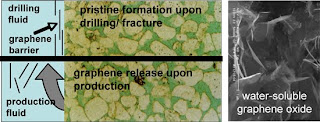Rice cuts deal to research graphene-infused drilling fluids. Nano additive would improve productivity of wells.
HOUSTON – A wall of graphene a single nanometer wide could be the difference between an oil well that merely pays for itself and one that returns great profit.
Rice University and Houston-based M-I SWACO, the world's largest producer of drilling fluids for the petrochemical industry, have signed an agreement for research funds to develop a graphene additive that will improve the productivity of wells.
James Bruton, M-I SWACO's vice president for research and engineering, said the time is right for his company to investigate the use of nanoparticles. "It's something we've wanted to get into, but it was obvious we would have to partner with those who are in the know about nanotechnology. So when a friend of our CEO's who knows Professor Tour asked if we were interested in visiting with him, we were happy to say yes."
Bruton said the cost of drilling fluids can reach $200 to $300 per barrel, and a well in the Gulf of Mexico might require more than 20,000 barrels to drill. "It's not a cheap undertaking for our customers, so the performance of the fluids is paramount," he said.
Tour emphasized the nanomaterials being studied are "clean tech" components in an environmentally sensitive field. "We've shown them to be nontoxic in many forms," he said. "It's all graphite-based, and that often comes from the ground anyway."
While the company's current focus is on drilling muds, Bruton said future research would focus on using graphene in completion fluids and other drilling products. "The ideas for using nanotechnologies are endless," he said.
"People often ask me what are we developing, and most of the time they want to know what's coming out tomorrow, next week, next month or next quarter," Bruton said. "In reality, I have to worry about things we're going to implement two to five years from now. That's where the step changes are. That's where we hope and believe nanotechnology, with Rice and Jim's group, will help us get to where we need to go." ###
Contact: David Ruth druth@rice.edu 713-348-6327 Rice University
















No comments:
Post a Comment